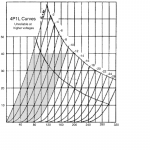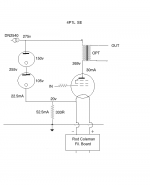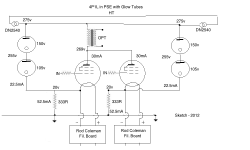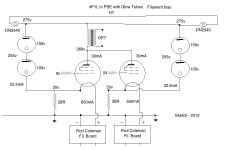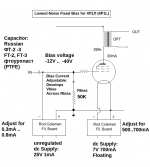thanks guys, makes sense now!
regarding the high power cathode resistor, can we wind our own? using this wire?
337 8 Ohm M Precision Resistor Wire Manganin Net 158 9g | eBay
if we could, we could wind it to any resistance we need.
bg
regarding the high power cathode resistor, can we wind our own? using this wire?
337 8 Ohm M Precision Resistor Wire Manganin Net 158 9g | eBay
if we could, we could wind it to any resistance we need.
bg
If you wind your own, you will get inductance, which may or may not be what you want in that position. The inductance might be too small to effect the operation, but worst case it will reduce the gain as the frequency goes higher, likely substantially out of band. Otoh, how much power do you think is needed? Power resistors are not terribly hard to find or buy.
Btw, I picked up a few of these tubes, thanks to Anatoliy's hearty endorsements!
_-_-bear
Btw, I picked up a few of these tubes, thanks to Anatoliy's hearty endorsements!
_-_-bear
I have a few of these funny pentodes on the way. Looking forward to playing with them.
Will be using some vintage Hashimoto iron to run the whole thing - PT & OPT. Probably 6SN7 to drive them, as I have some in stock. Need to figure out a filament supply for the 4P1L. Will experiment with other inputs tubes, too.
Will be using some vintage Hashimoto iron to run the whole thing - PT & OPT. Probably 6SN7 to drive them, as I have some in stock. Need to figure out a filament supply for the 4P1L. Will experiment with other inputs tubes, too.
That is a topology discussed at length by Michel Koster and Revintage in other threads which is really interesting. Lars was after 6p21with Schade feedback driven by a depletion MOSFET. 4p1l MOSFET driving 4p1L in Schade is definitely an option to look for. Greater efficiency out of the 4p1l and minimum components. Again, key question here is about the sound.....
Ale
Ale
With the low voltage operating point of the 4P1L and the low grid bias this limits the power output no matter how may we parallel. Most of the testinig with this tube was done as a OTL preamp so just a couple volts swing, I don't see the linearity as being better than a 6C4C for a budget rusky SET output tube.
For a all DHTSET amp may serve well as a driver butdoesn't have enough gain on its own and needs a input tube
Where this tube would really excel is as a A/B P-P output IHMO.
For a all DHTSET amp may serve well as a driver butdoesn't have enough gain on its own and needs a input tube
Where this tube would really excel is as a A/B P-P output IHMO.
As an output tube the 4P1L probably isn't more linear than a 6C4C, but I'm sure it's comparable. It's a great sounding tube. I agree about the low operating point and grid bias, but if you are OK with the lower power it's a good option.
But all this ignores what for me is the BIG reason to use the 4P1L. You can use it in filament bias quite easily. What does this mean? It means tiny cathode resistor and no cathode bypass cap. If you compare PSE 4P1L with SE 6C4C, both with conventional bypassed resistor bias, then it's no better. In filament bias it IS better!
There are not many DHTs that can be used as outputs in filament bias. The 4P1L is easy. 6P21 is possible - haven't tried it. 10Y is possible but getting more difficult to implement. 6C4C and 300b are just too demanding. Scrapping the cathode bypass resistor removes a veil to the sound and is an important upgrade, but then you need a small cathode resistor and that points to filament bias. Fixed bias is another option, but then that has to be absolutely pure to sound good. I never achieved that.
But all this ignores what for me is the BIG reason to use the 4P1L. You can use it in filament bias quite easily. What does this mean? It means tiny cathode resistor and no cathode bypass cap. If you compare PSE 4P1L with SE 6C4C, both with conventional bypassed resistor bias, then it's no better. In filament bias it IS better!
There are not many DHTs that can be used as outputs in filament bias. The 4P1L is easy. 6P21 is possible - haven't tried it. 10Y is possible but getting more difficult to implement. 6C4C and 300b are just too demanding. Scrapping the cathode bypass resistor removes a veil to the sound and is an important upgrade, but then you need a small cathode resistor and that points to filament bias. Fixed bias is another option, but then that has to be absolutely pure to sound good. I never achieved that.
Hi Andy,
If you don't like fixed bias, it's more than likely the lack of noise rejection (passive solutions), or real noise injection (any regulator with a bandgap reference - i.e. 99% of them).
If you like the bias performance that the Filament Regulators provide, but don't want to deal with the huge power dissipation, you could try separate regulators for each.
The diagram shows the idea. The Filament is heated normally, and a second regulator provides an adjustable current that is fed into the 50K bias resistor.
0.5mA gives 25V at very low noise - probably 100x lower than typical gas tubes. In fact the noise should be lower than with filament bias, since excess-noise in resistors in often proportional to current.
Recent regulators are temperature-compensated, allowing a stable supply to be developed. Why not give it a try!
If you don't like fixed bias, it's more than likely the lack of noise rejection (passive solutions), or real noise injection (any regulator with a bandgap reference - i.e. 99% of them).
If you like the bias performance that the Filament Regulators provide, but don't want to deal with the huge power dissipation, you could try separate regulators for each.
The diagram shows the idea. The Filament is heated normally, and a second regulator provides an adjustable current that is fed into the 50K bias resistor.
0.5mA gives 25V at very low noise - probably 100x lower than typical gas tubes. In fact the noise should be lower than with filament bias, since excess-noise in resistors in often proportional to current.
Recent regulators are temperature-compensated, allowing a stable supply to be developed. Why not give it a try!
Attachments
With the low voltage operating point of the 4P1L and the low grid bias this limits the power output no matter how may we parallel. Most of the testinig with this tube was done as a OTL preamp so just a couple volts swing, I don't see the linearity as being better than a 6C4C for a budget rusky SET output tube.
For a all DHTSET amp may serve well as a driver butdoesn't have enough gain on its own and needs a input tube
Where this tube would really excel is as a A/B P-P output IHMO.
Would you be so kind to explain how did you get to such conclusions? If you care to read the thread from the beginning, at least first 5 pages, you will see why I don't see any valid points in them.
However, if you use the tube in some regime regardless of it's properties you may get really bad results, but it does not mean that the tube is bad. That means don't use tubes on too low for them voltages, that's it.
Anyone tried 4p1l to drive gm70? I heard it couldn't but i cant see why not?
It could swing 160-180v surely.. with a ccs or interstage then just needs ~<20v in so 3 stage or 4p1l line stage and very little excess gain for low level recordings with 2vrms sources.
does this sound feasible?
enzo
It could swing 160-180v surely.. with a ccs or interstage then just needs ~<20v in so 3 stage or 4p1l line stage and very little excess gain for low level recordings with 2vrms sources.
does this sound feasible?
enzo
Anyone tried 4p1l to drive gm70? I heard it couldn't but i cant see why not?
It could swing 160-180v surely.. with a ccs or interstage then just needs ~<20v in so 3 stage or 4p1l line stage and very little excess gain for low level recordings with 2vrms sources.
does this sound feasible?
enzo
This idea is also on my mind. It should work, however, I suspect you will not be able to drive the GM-70 very hard.
- Home
- Amplifiers
- Tubes / Valves
- One more 4P1L SE
